How research and funding were “Aryanised”
The German Research Foundation zealously obeyed the new NS regulations. It dismissed its Jewish employees, excluded Jewish researchers from research funding and examined applicants for their political reliability.
- On the treatment of Jewish employees of the Notgemeinschaf(externer Link)
- No granting of fellowships to non-Aryan(externer Link)
- Destruction of funding records of Jewish researcher(externer Link)
- Expulsion of Jewish researchers from universities and Kaiser Wilhelm Institute(externer Link)
- The relationship of the NS regime to universities, academies of sciences and humanities and the Kaiser Wilhelm Societ(externer Link)
- The “Staffing Unit(externer Link)
- The staff questionnair(externer Link)
- On the other hand: new NSDAP membership(externer Link)
- Further Informatio(externer Link)
On the treatment of Jewish employees of the Notgemeinschaft
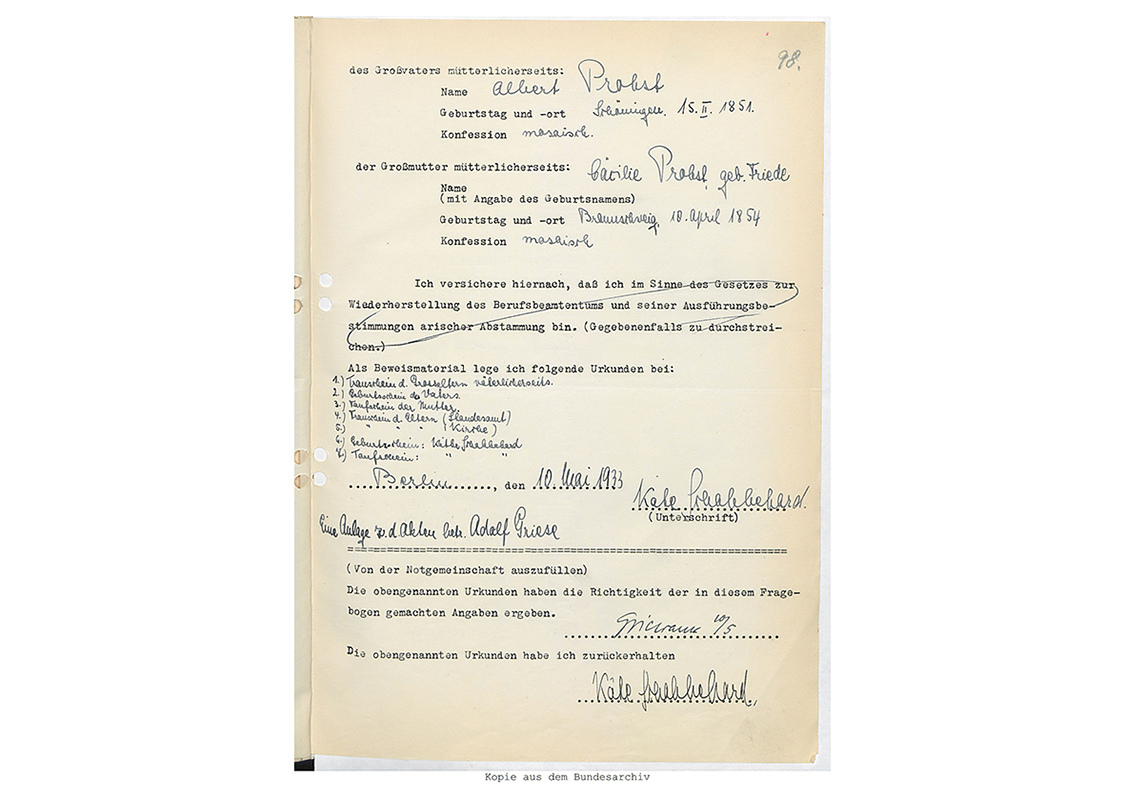
Extract from Käthe Schabbehard's personal information form
© Bundesarchiv Berlin-Lichterfelde: R 1501/126769-c, Blatt 98, Deutsche Forschungsgemeinschaft
On 7 April 1933 the “Gesetz zur Wiederherstellung des Berufsbeamtentums“ (Law for the Restoration of the Professional Civil Service) entered into force, which excluded Jewish and politically undesirable civil servants and employees from the civil service. The “Aryan Paragraph” (Paragraph 3) formulated in that law forbade the employment of “non-Aryans” in the civil service, who were to be placed in immediate retirement. A “non-Aryan” was considered to be anyone and everyone with a Jewish parent or grandparent.
In a letter dated 24 April 1933, the Notgemeinschaft was called upon to name civil servants, employees or workers who should be dismissed from service due to this law. The top management of the Notgemeinschaft, in which clear anti-Semitic tendencies had been discernible even before 1933, immediately met this demand and had all employees fill out descent questionnaires.
In the head office, Käte Schabbehard, an employee of the Library Committee, was affected. Her maternal grandparents were Jews – stated on the questionnaire as faith “Mosaic”. She described the services of her stepfather in the World War on an additional sheet, presumably in the hope that they would be honoured and might tip the scales in favour of waiving a dismissal.
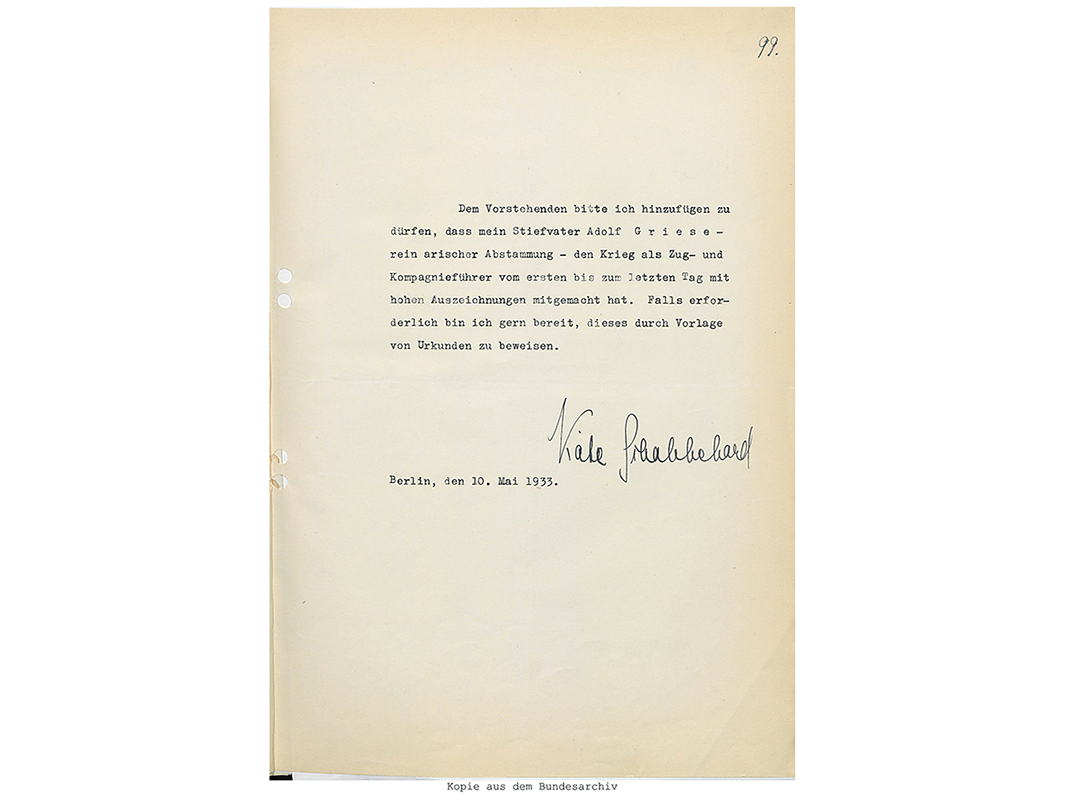
Extract from Käte Schabbehard's personal information form
© Bundesarchiv Berlin-Lichterfelde: R 1501/126769-c, Blatt 99, Deutsche Forschungsgemeinschaft
After evaluation of the questionnaires, on 12 May 1933 the President of the Notgemeinschaft informed the Reich Ministry of the Interior of the result.
“Due to non-Aryan descent, the employee Käthe Schabbehard comes under the provisions of the Law for the Restoration of the Professional Civil Service. The questionnaire filled out by her is attached. In her ten years of work with the Library Committee of the Notgemeinschaft she has distinguished herself by diligence, reliability and proficiency, and is particularly useful due to her wide knowledge of the operations of the past years. The Notgemeinschaft is serving her with a notice of termination in accordance with the provisions of the law named and its implementation directive.”
But the implementation directive of 4 May 1933, Section 5 stated that a notice of termination “had to be served on the recipient by 30 September 1933 at the latest”. In other words, Friedrich Schmidt-Ott would have had no need to pronounce the termination so quickly, and could have left further action open in the letter to the Reich Ministry of the Interior.
No granting of fellowships to non-Aryans
The Executive Committee conducted itself similarly in its decision no longer to grant fellowships to “non-Aryans”. In a letter to the Reich Ministry of the Interior dated 12 June 1933, Vice-President Viktor Schwoerer did in fact state that the provisions of the Law for the Restoration of the Professional Civil Service “did not apply”. However, instead of leaving the matter at that, he drew attention to the “Law against the Overfilling of German Schools and Higher Education Institutions” of 25 April 1933, in which the quota of German “non-Aryans” at higher education institutions was fixed.
“However, we believed that we should apply the provisions of the Law against the Overfilling of German Schools and Higher Education Institutions of 25 April 1933 by analogy. The Notgemeinschaft has therefore abstained from granting fellowships to non-Aryans since the enactment of the latter legislation.”
Evidently the Reich Ministry for the Interior was only first made aware of this issue by the inquiry of the Notgemeinschaft. In September 1933, the Reich Ministry of the Interior finally decided
“that there can be no question of granting of fellowships by the Notgemeinschaft to non-Aryans until further notice. Half-Aryans should only receive a fellowship in particularly urgent cases, and only if there are no Aryan requests."
Destruction of funding records of Jewish researchers
As part of a study on the expulsion of Jewish researchers from Germany, historian Lothar Mertens evaluated funding records of the Notgemeinschaft during the National Socialist era. The result of this study was that no funding records existed for more than one hundred grant recipients who had been listed in the grant lists of the Joint Committee for the years until 1933. Mertens found out that the funding recipients – professors, lecturers and assistants – were all of Jewish descent. Evidently the funding records had been “disposed of” in the mid-1930s for all researchers of Jewish descent expelled from the higher education institutions because they were no longer potential applicants due to their “non-Aryan” descent.
Expulsion of Jewish researchers from universities and Kaiser Wilhelm Institutes
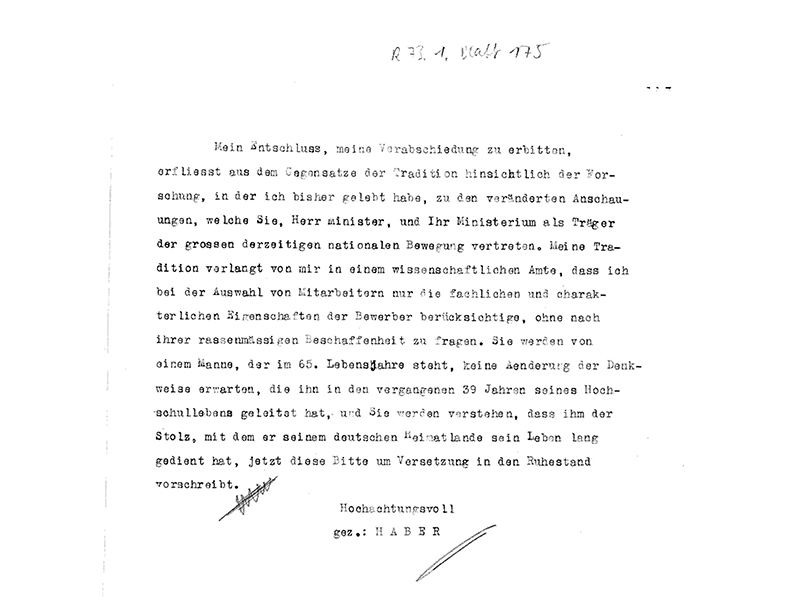
Fritz Haber's explanation of his resignation: the incompatibility of his work as a scientist with the conditions of National Socialism
© Bundesarchiv Berlin-Lichterfelde: R 73/1, Blatt 175, Deutsche Forschungsgemeinschaft
The discriminatory laws on the exclusion of Jewish researchers and the dismissal of “non-Aryan employees”, which the Notgemeinschaft implemented in a conscientious and zealous fashion, applied primarily to universities, but also to scientific establishments such as the Kaiser Wilhelm Institutes.
Around 15 percent of all professors and lecturers in the German Reich were affected by the Law for the Restoration of the Professional Civil Service and the mass dismissals that started thereafter. The behaviour of professors in reaction to the dismissals of their Jewish colleagues ranged from passive acceptance to active encouragement. Objections and protests occurred only in isolated cases. Many junior staff saw a chance for their own career in the dismissals. In addition, many researchers themselves thought in a racist manner and accepted or willingly supported the exclusion of Jewish and “non-Aryan” colleagues.
Over one hundred researchers were dismissed from the Kaiser Wilhelm Society, including 35 heads of institutions. The most famous of them included Albert Einstein, Fritz Haber and Lise Meitner. Max Planck, President of the Kaiser Wilhelm Society and concurrently Vice-President of the German Research Foundation, assessed Otto Hahn's proposed protest against the mass dismissals without any illusions:
“If 30 professors stand up today and protest against the behaviour of the government, 150 people will come along tomorrow who declare their solidarity with Hitler because they want the positions.”
Of 49 employees in the Kaiser Wilhelm Institute for Physical Chemistry and Electrochemistry, twelve were “not Aryan” within the meaning of the law, including head of the Institute Fritz Haber. Although he was exempted from the Law due to his military standing, he did not want special status for himself while his Jewish employees were being sacked. In his request for retirement on 30 April 1933, he explained his resignation with the incompatibility of his work as a scientist with the conditions of National Socialism.
“[...] My tradition demands of me in a scientific office that in selecting employees I take into account only the applicants’ professional and personal qualities, without inquiring into their racial characteristics. You will not expect of a man who is in his 65th year that he change the way of thinking that has guided him over the past 39 years of his academic life, and you will understand that the pride with which he has served his German homeland for his entire life now dictates this request to be placed in retirement.”
The relationship of the NS regime to universities, academies of sciences and humanities and the Kaiser Wilhelm Society
The higher education institutions as purely state-run institutions were most affected by interference by the National Socialist authorities. After the seizure of power, decision-making authority was shifted from the higher education institutions to the government and party bureaucracy, and professors were partially stripped of their powers. Around one-fifth of German academic teaching staff were expelled from their positions – and therefore also from the Notgemeinschaft.
From the National Socialists’ perspective, the Academies of Sciences were situated closer to the margins of science and scholarship. Until 1938/1939 they were able to operate relatively freely and could often retain their Jewish members until 1938.
The Kaiser Wilhelm Society (KWG) was an institution organised under civil law, which was partly funded by private donors. Given its institutes that were vital to armament, it was too important for the NS rulers and consequently “irreplaceable”. Thus the early threats to dissolve the KWG soon fell silent and it was not until 1937 that the self-governance structure began to be compromised.
An example of National Socialist zeal is a note sent by an employee in the liaison staff of the NSDAP to its head Rudolf Hess, and “for reasons of competence” to the Reich Ministry of the Interior in July 1933, in which he called for the “Gleichschaltung” (enforced conformity) of the Notgemeinschaft and the KWG.
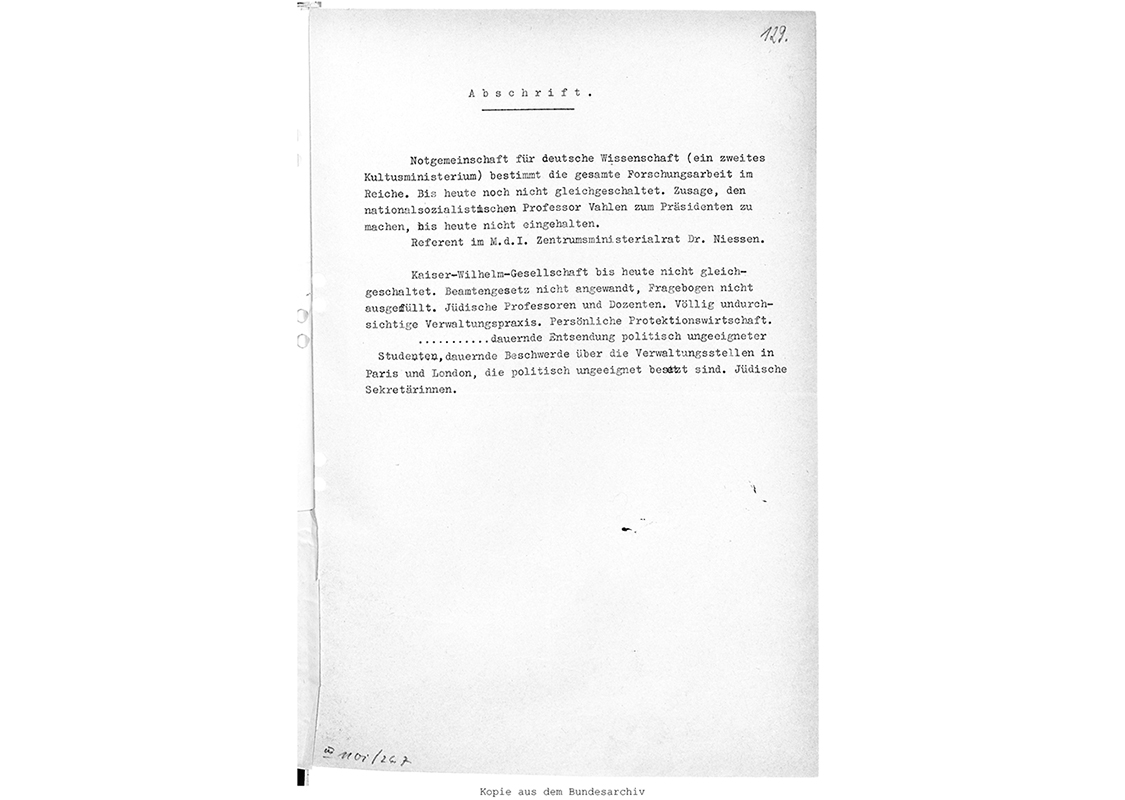
Note by an employee of the NSDAP liaison staff which he sent to its head Rudolf Hess and “for reasons of competence” to the Reich Ministry of the Interior in July 1933, in which he called for the “Gleichschaltung” (enforced conformity) of the Notgemeinschaft and the KWG
© Bundesarchiv Berlin-Lichterfelde: R 1501/126769-c, Blatt 129, Deutsche Forschungsgemeinschaft
The “Staffing Unit”
From 1935 at universities and higher education institutions, the filling of academic teaching or assistants’ positions was preceded by a review of candidates' political reliability. Teaching accreditation was tied to criteria such as Aryan descent and unconditional support for the NS state. The Dozentenschaft, the representative body of professors and assistants decreed by the NS government, demanded a review of every professor or assistant under consideration.
The Notgemeinschaft complied with this practice and in 1935 it established the “Staffing Unit” with SS man Johannes Weniger as its head. It obtained information about the political, ideological and character reliability of potential fellowship recipients by making inquiries of the NS Dozentenbund (NS Lecturers’ League) and – if these were not sufficient – the local police and Gestapo units. The primary aim of checking fellowship applicants was to groom potential NS-compliant future university teachers.
The political assessments constituted a pre-selection, since evidently after a completely negative review a funding file was not even set up, and the academic and scientific relevance of the funding applied for was not examined. Private good behaviour hence became a criterion that downgraded the individual competence of the applicants and the discipline-specific relevance of the proposal to secondary selection criteria.
The reviews contained a broad spectrum of anti-Jewish hostility and typical NS prejudices: For example, a negative note was made about one applicant that he had “defended Jewish lecturers”. The fellowship application of another researcher was decided in the negative because he was “continually in the company of Jews and former communists”. The application of a researcher from Göttingen was “definitely to be welcomed, if something finally happened for him”, because he “did not have an easy time at the Mineralogical Institute run by Jews”. An applicant who was initially described in the review as “not reliable” nevertheless received praise from the NSDAP Gauleitung, which had thereupon been consulted, because he made “a good impression and might be categorised as a good German”.
In 1937, political checks had largely become obsolete, since politically suspect people had been removed from higher education institutions, and party membership of the NSDAP no longer constituted anything special due to the large numbers of people becoming party members. In addition, more priority had to be given to qualifications in the discipline once again because research was gaining importance for war planning, and sound professional expertise was required. At the same time there was a shortage of qualified junior staff. The Nachwuchsamt des Reichsforschungsrates (Junior Staffing Office of the Reichsforschungsrat) was created during the war in order to find especially talented young staff at universities and universities of applied sciences. It established a “performance register for students” and a “junior staff register for lecturers”.
The staff questionnaire
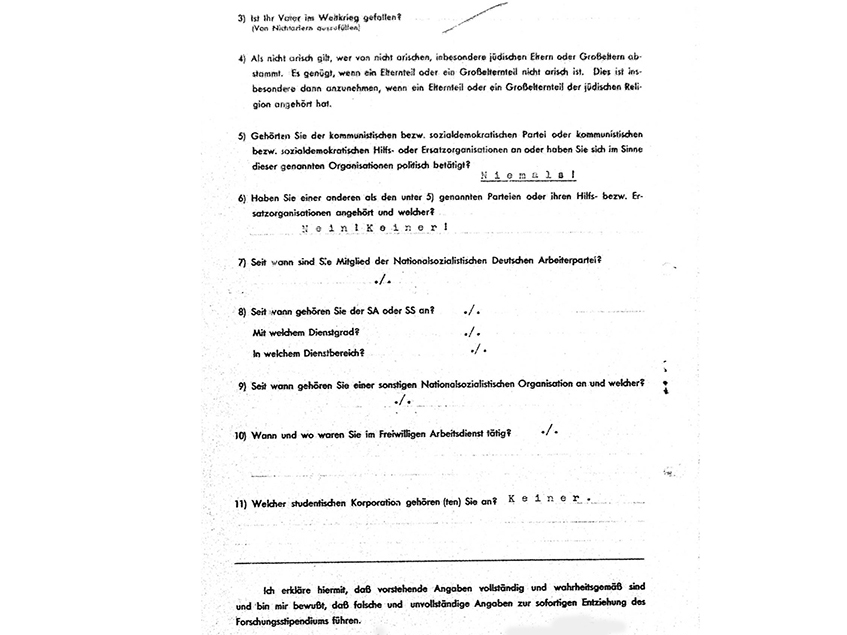
Extract from a staff questionnaire
© Bundesarchiv Berlin-Lichterfelde: R 73/11609, Notgemeinschaft
The staff questionnaire, which applicants for a research fellowship had already been required to fill out in the 1920s, was expanded several times under National Socialism. From spring 1933, in addition to filling out the staff questionnaire, applicants also had to fill out an attachment in order to prove “Aryan descent”. In the 1934 version, the list of questions on previous political activities was significantly expanded.
On the other hand: new NSDAP memberships
For their part, researchers conformed to the new political conditions and joined the NSDAP in greater numbers after 1933. Such new registrations were critically dubbed “the March fallen,” “May beetles” or “profiteers”. The party membership of fellowship applicants increased significantly in the Notgemeinschaft, also, after the Reichstag election in March 1933. Party membership paid dividends for many a fellowship recipient: party members were more likely to receive an increase in their fellowship than non-party members, and NSDAP members were also funded for longer.
Further information
Access to the historical records
“GEPRIS Historisch” is the comprehensive information portal provided by the DFG that makes the history of the DFG and of research between 1920 and 1945 publicly accessible:
Information on literature used and sources